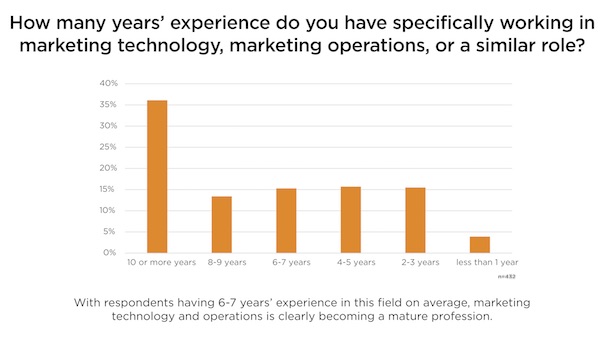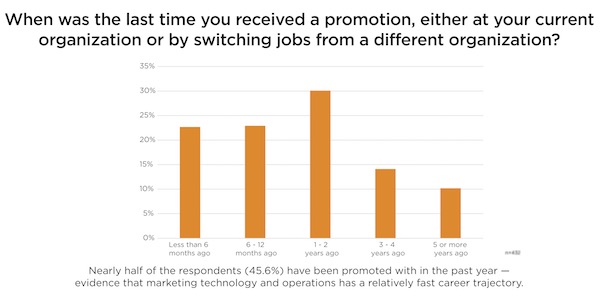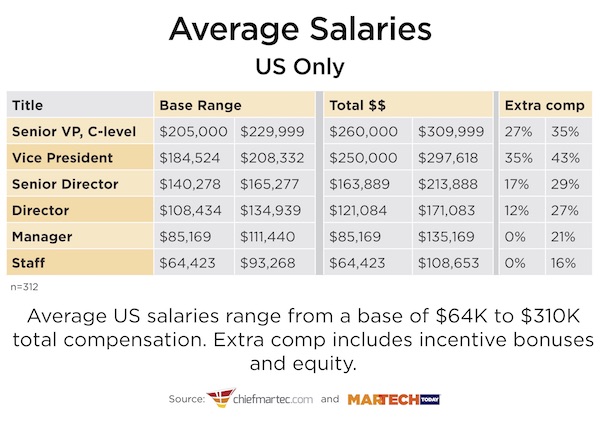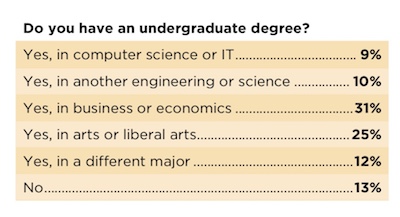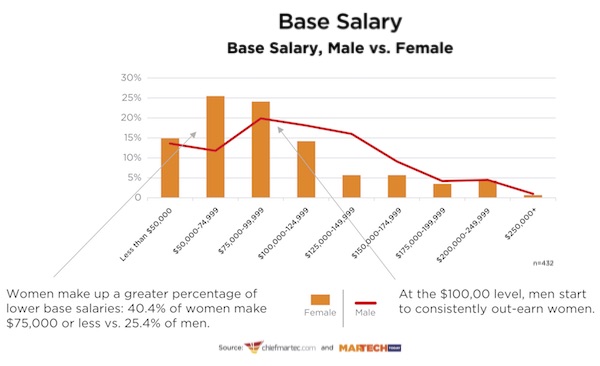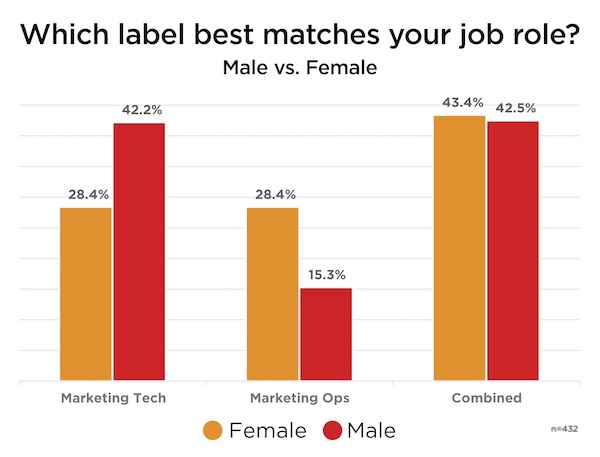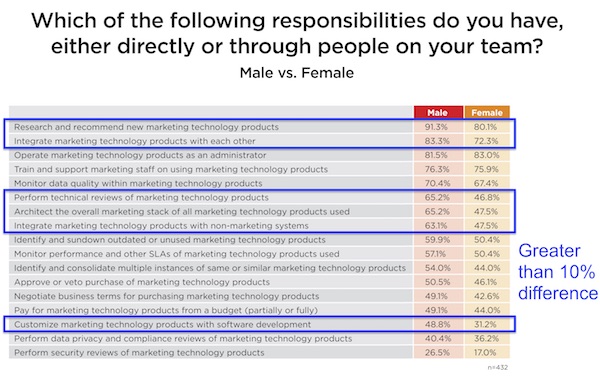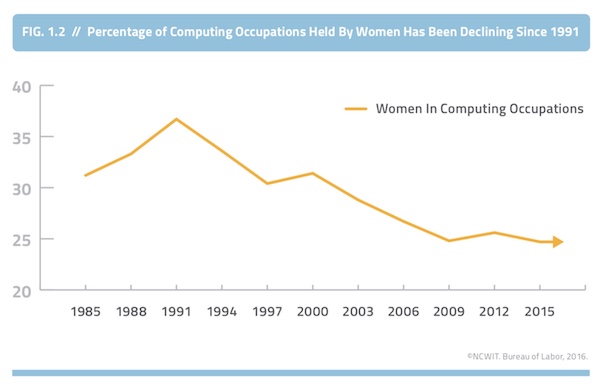For martech careers, there is a lot of really good news. But one thing that isn’t.
First, thank you to the 884 professionals who participated in our 2018 Marketing Technology & Operations Salary Survey, a collaboration between myself and the team at MarTech Today.
For our analysis, we filtered it down to only the n=432 who explicitly identified their role as marketing technology, marketing operations, or a combination of the two (the most common occurence).
Let’s start with the good news. Marketing technology and operations careers are thriving across the entire professional spectrum:
- Marketing ops & tech roles exist at organizations of all sizes, from companies with less than 100 employees to those with more than 10,000. Participants in our survey were pretty evenly distributed across the entire range: 43% in firms over 1,000 employees; 57% in firms under 1,000.
- Marketing ops & tech roles exist in both B2B and B2C. 49% of our participants were from B2B, 16% from B2C, and 35% from companies that do both B2B and B2C marketing.
- Marketing ops & tech roles exist at all levels of the marketing organization, from staff and manager roles up to VP and senior VP. In our survey, 41.3% of all participants were director level or above.
Marketing technology and operations is steadily becoming a more mature profession. The participants in our survey had an average of 6-7 years experience in the field.
Not coincidentally, it was 7 years ago, in 2011, that I published my first marketing technology landscape graphic, showing the beginnings of martech’s Cambrian explosion. Who imagined it would grow more than 3,000% over the years ahead?!
But martech is also a profession where careers — like the technology itself — are advancing quickly. Nearly half (45.6%) of the respondents in our survey have been promoted within the past year. 75% have been promoted within the past two years.
Martech is also a pretty good paying profession too.
You can see the range of U.S. salaries for each level in the above chart. Most have additional compensation through bonuses and equity — stock or stock options — that typically amounts to an extra 20% or more.
To see the full range of total compensation packages for martech roles at all levels — including how global averages different from the U.S. — download our complete 2018 Marketing Technology & Operations Salary Survey report (free, but gated behind a form).
One finding that was a bit surprising to me in the demographics of the survey’s participants was their undergraduate degree.
Only 19% had a degree in computer science, IT, or another engineering or science discipline. I would have expected that to be higher.
The most popular undergraduate degree? Business or economics (31%), followed by a degree in the arts or liberal arts (25%).
But so far, all of this sounds pretty good, right? What’s the bad news?
Gender Gaps in Marketing Operations & Technology
When we designed this study, we decided to ask participants their gender. I was curious to see if there would be significant differences in compensation, job level, or responsibilities on that axis. I uneasily anticipated that there might be, given such differences show up in many other professions, especially those that are tech-related.
But whether it was optimism or naïveté — or, more personally, thinking of my own daughter — I was really hoping there wouldn’t be. I’d like to think of martech as a progressive profession.
But there were significant differences. And if not surprising, they were still disappointing.
We ended up adding an entire “Gender Gaps” section to the full report, but the biggest gap was in base salary: 55% of men have a base salary of more than $100,000, compared to only 35% of women. When we look at total compensation, 34% of men earn $150,000 or more in salary, bonus, and equity — compared to 19% of women.
This correlated with a gender gap in job level: 48% of men held director-level positions or above, compared with 30% of women.
There was also an interesting difference in the role that participants associated with. Men were much more likely to be in a pure marketing technology role than women — 42.2% compared to 28.4%. And vice versa, women were much more likely to be in a pure marketing operations role than men — 28.4% to 15.3%.
It was encouraging, however, to see that in combined marketing operations and technology roles, gender distribution was essentially equal.
There were also gender differences in some responsibilities:
There was generally a 10% or greater difference in the number of men who had more technical responsibilities compared to women. Some of that is undoubtedly a function of the role bias for marketing technology versus marketing operations.
But it’s arguably a symptom of an unfortunate pattern that’s much larger than martech: more technical roles, even in marketing, tend to have more men than women. Statistics from the Bureau of Labor and the National Center for Women & Information Technology show that this is a problem at a macro-level across “computing” professions in general:
I suppose by those stats, marketing technology and operations is slightly better than average — the overall split of participants in our study were 33% female and 66% male — but it is far from good. We still have work to do in martech.
But there is some evidence that such work is underway. In our survey, 31.2% of women had been promoted in the past 6 months compared with 18.8% of men.
Download the complete 2018 Marketing Technology & Operations Salary Survey report for more details.
P.S. We’re committed to helping address gender imbalances in our industry through the MarTech conference. Approximately half our speakers at our upcoming event in San Jose, April 23-25, will be amazing women martech leaders.
Also, if you’re willing to participate in The Stackies 2018: Marketing Tech Stack Awards, we’re donating $100 on behalf of every entry to Girls in Tech, up to a total of $10,000. Will you contribute a slide of your marketing stack to help us reach that goal?

